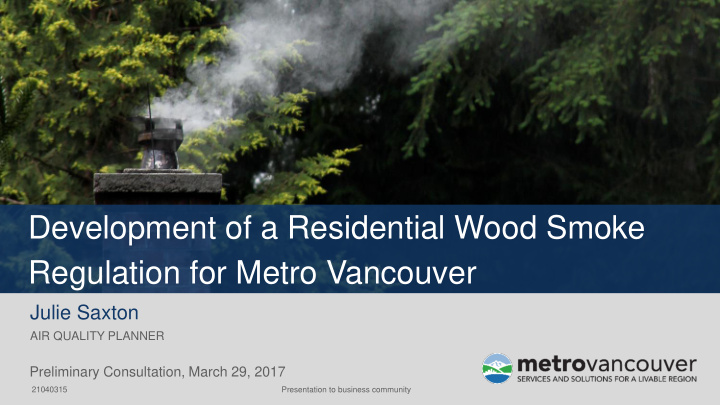



Development of a Residential Wood Smoke Regulation for Metro Vancouver Julie Saxton AIR QUALITY PLANNER Preliminary Consultation, March 29, 2017 21040315 Presentation to business community
Air Quality Impacts • Approximately 100,000 fireplaces and stoves in use in the region • Largest source of annual fine particulate emissions in region • Higher proportion in winter • Higher intake of fine particles in dense neighborhoods 2
Health Impacts • Fine particles (PM 2.5 ) are harmful • Additional health risk factors: • Incomplete combustion • Wood containing paints, metals, adhesives • Toxic Air Pollutants Risk Assessment • Ranked ninth for lifetime cancer risk • Second top source of toxic air pollutants, after diesel engines 3
Regional Health and Economic Impacts Analysis • Literature search • Policy review • Affordability and equity assessment • Modelling of health-related costs • Air Quality Benefits Assessment Tool 4
Health Literature Wood smoke in BC associated with • Risk of heart attack in seniors • Inner ear infections in infants Increased emergency room visits and hospital admissions associated with wood smoke 5
Health Outcomes • 20 to 70 fewer ER visits for heart and lung conditions • 2,000 to 6,000 fewer asthma symptom days • 6,000 to 150,000 fewer restricted activity days 6
Model Scenarios Percent decrease in Contribution to ambient PM 2.5 Scenario Exemptions? ambient PM 2.5 concentration during wood burning season A X Moderate 7 B Moderate 5 C X High 16 D High 13 7
Economic Impacts Cost benefits • All endpoints: $280 million to $870 million • Endpoints except chronic exposure mortality: $20 million to $65 million • Savings without exemptions: $10 million Heating necessity and fuel poverty 8
Approaches elsewhere • City of Montreal • Bylaw adopted in 2015 • Port Alberni • Bylaw adopted in 2012 9
Current Initiatives • Wood stove exchange program rebates • Wood heat workshops • Educational video on social media • Cool weather air quality bulletins • Wood smoke forecasting tool • Caring for the Air reports 10
Current Regulatory Status • Air Quality Management Bylaw 1082: • Restricts fuels allowed to be used • Requires operation in a manner that minimizes emissions • Generally prohibits causing air pollution 11
Process for Developing a Residential Wood Burning Regulation TODAY Board Board Draft Considers Considers Preliminary Public Intentions Consultation Intentions Consultation Bylaw Paper Paper Adoption 12
Potential policy options (1) • Restrictions on use of residential wood burning appliances based on appliance’s level of emissions • Exemptions from restrictions • No other sources of heating • Financial hardship • During exceptional events • Distance from neighbours 13
Not a ban on all appliances 14
Potential policy options (2) • Indicators of excessive wood smoke production • Additional restrictions that may be applied during periods of degraded air quality 15
Feedback by April 13 • Meetings and webinars • RWB@metrovancouver.org • 604-432-6200 • www.metrovancouver.org (search “reducing smoke”) • Feedback form, survey, webinar slides • Feedback accepted until presented to Board 16
Questions or Comments?
Recommend
More recommend